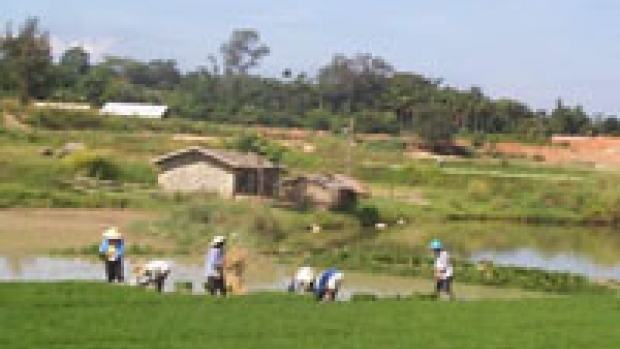Growing more rice with less water

In China rice is the main food staple for most of the 1.3 billion people. Most of this rice is grown using irrigation. Traditionally rice seedlings are grown in nurseries then transplanted into flooded fields, growing under a layer of water. This deprives air to the root zone, creating optimal conditions for growth.
Producing one kilogram of unprocessed rice under irrigation is estimated to use between 1500 and 5000 litres of water, depending on the local climate, soil type and rice variety.
Competing demands
China’s rapid pace of development is placing a series of competing demands on water resources — for industrial, urban and rural uses. These demands are competing with those of the agriculturale sector, including irrigated rice.
Water is allocated at a district level, through a series of irrigation schemes and systems. Officials managing these systems are responsible for weighing the competing demands for water and allocating these to end-users. Individual farmers do not pay for water directly, instead paying agricultural taxes and levies. This makes the use of savings incentives or added taxes to reduce water consumption less effective.
The challenge facing national policy makers, irrigation authorities and farmers is how best to maintain and increase rice yields, and other food production, while reducing total agricultural water use.
There is potential to save water in traditional rice production systems. Bunds, or earthen mounds, are used to separate fields and hold water in place. The fields are flooded to a depth of between five to ten centimetres. Water is lost from seepage through bunds, percolation into soils and evaporation. The level of losses depends on the condition in which bunds are kept, and on the level of permeability of soils.
Increasing productivity
Two approaches to reducing water use without reducing rice yields are being investigated. The first focuses on irrigation management as an impetus to reduced water consumption. Supporting this are trials of new techniques for growing irrigated rice that reduce water use. The efficacy of these techniques is now being tested.
Farmer field experiments, survey data and system and sub-basin modelling in two irrigation systems in the Yangtze and Yellow River basins, have shown that irrigation authorities can reduce irrigation supplies for agriculture without detriment to farmer yields and incomes.
One approach is alternating wetting and drying of fields. Chinese researchers and farmers pioneered the use of controlled irrigation aimed at reducing percolation and seepage. At the farm level this involves allowing the field to dry out for a few days after ponded water has disappeared, before re-irrigating.
Under favourable high rainfall conditions, and a landscape that permits surface storage of rainfall runoff in farm ponds, authorities can reduce supplies to irrigation canals. ACIAR research has shown that farmers won’t adopt alternate wetting and drying if water is available to follow traditional practices. When water supplies are short, farmers adopt alternate wetting and drying, their ponds providing water when canals run dry.
Hybrid rice
Yields of hybrid rice are the same under continuous flooding and alternate wetting and drying, as long as saturated conditions are maintained in the root zone. Weeding may be needed to ensure rice achieves full growth.
Farm-level water savings through reduced irrigation supply have been introduced to the Zhanghe Irrigation System in the Yangtze basin. Field level water use is about two-thirds the average across Asia. Water productivity at the farm level has increased, reducing use by 10–15 per cent. Crop growth simulation models are extrapolating these results to other biophysical environments.
The wetting and drying approach is not suited to low rainfall water-scarce areas, such as in the Yellow River basin. Here the topography does not permit water storage in ponds. Near the river there is a shallow groundwater level as the irrigation district is lower than the river bed. The depth of the shallow water table can be lowered by distributed groundwater pumping. System managers can encourage this by cutting off canal water to farmers near the river, coupled with subsidies for installation of shallow groundwater pumps as an alternative irrigation supply. The saved water can be distributed to farmers further from the river. A groundwater model is being used to develop guidelines for system managers to encourage shallow groundwater pumping in farms near the river.
Crop modelling
The alternate wetting and drying technique has been accepted at the national level in China. Water productivity has been selected as an indicator for evaluation of the modernisation and rehabilitation of irrigation schemes, and the assessment of all water-saving projects in China. Modelling is helping system managers adopt water-saving approaches that don’t disadvantage farmers.
Irrigation can also be reduced through new techniques such as saturated soil culture, a system that relies on forming farming beds. Crops are grown on raised beds, separated by furrows in which a shallow depth of water is maintained. In Australia, rice grown with saturated soil culture used 32 per cent less irrigation water than conventional methods in wet and dry seasons. ACIAR is supporting trials of permanent raised beds in mixed cropping systems (rice–wheat and other combinations) in India, Pakistan and China. These balance yields gains in one crop against whole of farm productivity, so small reductions in rice yields are possible.
The use of aerobic rice varieties will also save water. These are high-yielding varieties that grow under non-flooded conditions in non-puddled, unsaturated (aerobic) soil. They respond to high fertiliser inputs, can be rain-fed or irrigated, and tolerate occasional flooding. Varieties are being tested in several countries, but are yet to be widely adopted.
All these approaches offer potential to substantially reduce water use, of which up to 80 per cent is used for agricultural production, freeing up more water for other uses.


